KLAX
More Fun Than Tetris
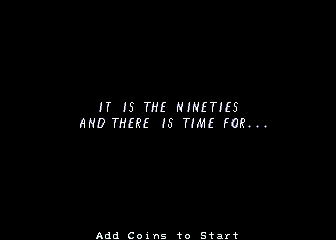
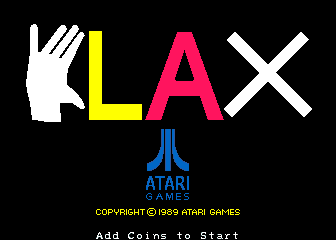
One day in the 1989 summertime, graphics and game-play designer Mark Stephen Pierce pondered the prevailing passion for real-time puzzles that the recent pervasion of Tetris had provoked, primarily via PCs and the Nintendo Game Boy. He determined that the coin-op company he worked for should make an original contribution, even if its own licensed version of the Russian game had just come out.
He parked himself in his office at Atari Games, opened a digital-painting application and fashioned a few unfussy figures in different colors, unconcerned with reasons or rules. He printed the shapes that seemed most suitable as puzzle-game pieces and pinned them to his wall, concluding within a couple of weeks that his game's players would stack tiles according to color, rather than joining blocks according to shape as in Tetris.
He foresaw funny, frantic attempts at preventing the approaching tiles from accruing overwhelmingly before the player could work out the most advantageous places to drop those already caught. Somewhere in the designer's mind was the I Love Lucy bakery skit, so it's no wonder that his finished product played a bit like Bally / Midway's Tapper from six years earlier. Despite the differences -- his playfield was horizontal, his "characters" were abstract, strategic foresight pertained, Tetris-like chain reactions were possible, and the player vied to put everything in its place instead of keeping it away -- the feeling of doing one's best to keep up with stuff that entered through the far border was comparable.
With Pierce's briefs (not that kind) in hand, Programmer Dave Akers concocted the Klax code at home on his Commodore Amiga, later translating it at work from AmigaBASIC into C. He then added his collaborator's recently revamped graphics and refined their mechanics. The artist himself had left for a three-week vacation; by the time he returned, Akers had the game up and running in the Video Lab, where it was all the rage with other Atari personnel.
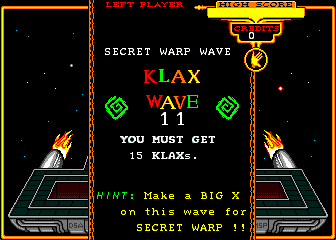
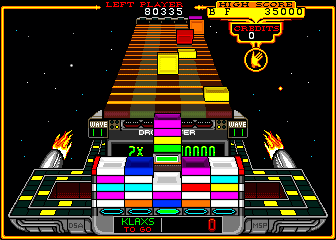
The two budget-conscious men mercifully chose to forego the frequency-modulation chip necessary for music, deciding instead on a synthesizer chip that would let them add digitized sounds and voices. The former were created Foley-style; to produce the latter, Akers (Atari 2600 Bump 'n' Jump, BurgerTime and Star Strike; arcade Escape from the Planet of the Robot Monsters) and Pierce (computer Dark Castle and Beyond Dark Castle; arcade RoadBlasters) rounded up their coworkers and recorded them in the Sound Lab. Thanks to the proficiency of sampling engineer Brad Fuller, everything from the game's warm applause and sympathetic groans to the impressed feminine exclamations and Pierce's falling-tile cry was clinched in a single day.
The game was named after the click-clacking sounds of the tiles as they somersaulted down five lanes (not the commonly cited conveyor belts, unless they were broken) toward the player's lane-wide, sideways-sliding platform. Despite its '89 copyright, the coin-op came out in February of the following year, with its first puzzle appearing upon power-up: "It is the nineties and there is time for...KLAX." Were the days expected to lengthen? Those nutty astronomers! Of course, the message might have simply reflected Pierce's laid-back attitude after a long time away from work.
When the game was sent to Atari Japan, the marketers, who were obviously as mentally ill as any others, were hesitant about releasing it in the East, expecting that the title would be confused for a pluralized version of the slang term "crack." While it was probably pronounced that way over there, it's unlikely that anyone who eventually played the game suddenly found himself drawn to drugs, at least before reaching the harder waves.
If you ask me, there's even more time for the game in the present decade. So there, '90s inhabitants. Here's the lowdown: The player moves his platform -- apparently a hacked-off podium top with a spring-loaded cup holder -- below five vertical tracks viewed from an elevated 3-D perspective. The randomly sequenced tiles look more like blank, quadrilateral dominoes. Their intervals dwindling throughout each wave, they flip-flop toward the platform, which can hold up to five at once. They're identically shaped but ever more varied in color as the game goes on, and a flashing, all-purpose version joins the others after the fifth wave.
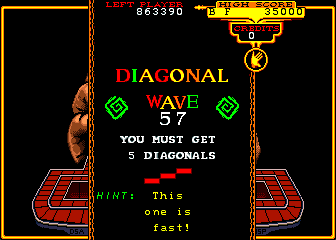
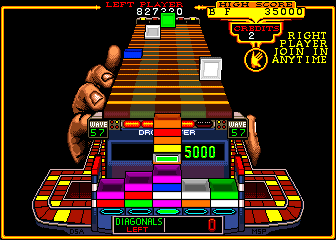
The large, empty (in earlier waves) shelf below the platform can hold up to five piles of five tiles. Whenever the player pushes the "Flip" button, he releases his highest (i.e. most recently caught) tile, aspiring to align at least three anywhere on the shelf. When this is achieved -- in a horizontal, vertical or diagonal manner, as in Tic-Tac-Toe -- they disappear, he collects points, and any higher tiles drop to fill the new gaps.
A missed tile won't obligingly fall onto the shelf, of course. It will elicit guilt with an anguished wail, even lacking visible vocal orifices, and the player will lose a turn. He begins with three, four or five, depending on his choice of starting wave. The chance to bypass five or ten waves is tendered once again after every fifth. The decision to skip ahead is rewarded with proportionate bonus points, provided that the initial wave is survived. In any case, the number of remaining turns ("Drops") is reset. Clearing the hundredth wave beats the game.
Note Wave 11's not-so-secret warping method, explained and carried out -- thank you, thank you -- in the second pair of screen shots above. If you too would like to win the 700,000 bonus points and skip fifty waves (I sound like a game-show host), plan on plunking the central tile last. Why, you're welcome!
The most significant difference between this game and all others that involve the organization of falling things is that those things can be stockpiled before placement, since the player catches them instead of shifting them as they fall. He's consequently afforded atypical time for contemplation. This is offset by the requirement to release them in the reverse order from which they've been caught.
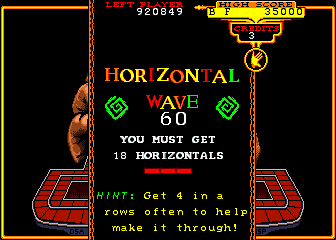
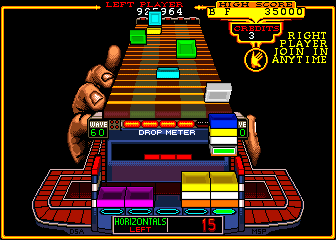
The surreal graphics surrounding the playfield, including the intermittently changing environs, are entirely ornamental but pretty damn cool nonetheless. I hope that giant hand doesn't drop the game, or my stacks will get screwed up. Anyway, each kind of tile emits its own cartoony flipping sound, and a hilarious "sproing" resounds if you push the button when your platform's empty. When it's full, the stable green of its front edge changes to blinking red, just in case you miss the squeaky cue and can't count to five. The same occurs beneath crammed columns as you glide over them, minus the blinking.
Each wave begins with relatively sparse tiles. Downward controller movement will accelerate their advancement if you grow impatient. Soon after, when they're overabundant, you're given some leeway: You can fling your topmost tile back upward, into the lane with which you're aligned. This should only be exploited as a last resort, as the tile will return between two others -- making things even more crowded -- or, even worse, in tandem with one. Pushing upward therefore doesn't provide a bail-out so much as a shuffling.
It's easiest and most instinctive to match tiles vertically (indeed, this configuration scores the least), but it often doesn't do you much good. One of the game's most attractive facets, and another that sets it apart from Tetris, Columns, Dr. Mario, etc. -- and makes it more fun than any of these, as far as I'm concerned -- is its "mission" approach. You're not simply lining up as many corresponding game pieces as you can; each wave poses its own objective. Any threat of monotony is thus checked.
The waves rotate through five general goals, but when a certain type comes around again, it's not quite the same as before, due to the game's gradual rise in difficulty. You're now contending with more colors and occasionally faster tiles (maybe they're heavier). You're called upon to assemble an appointed amount of horizontals, diagonals or mere "Klaxes," which all threesomes are; score a stipulated sum; or "survive" -- catch -- a tendered total of tiles. A line of four counts as two Klaxes, five as three. A handy accessory is the calculator readout-like meter at the bottom. This indicates how many qualifying Klaxes await creation in the current wave.
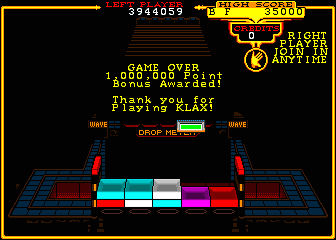
An especially accommodating element, and one that's indicative of the game's exemplary, elaborate equilibrium, is the second-long pause in tile advancement that rewards you beyond the score for a match-up. You can still move, drop tiles and so forth, so the brief breather works wonders on staying caught up. When it's not reporting on bonus points, the squat screen just above the shelf pictorially reminds you which type of formation to construct (when this applies), lest the lower readout isn't enough. Irrespective of the current objective, any sort of Klax can be deployed for elimination, in the interest of a higher score or tidier shelf.
Nearly every wave looks easy at first. As the tiles emerge closer and closer together, however, quicker thinking is necessary; you ultimately face an outright onslaught. Thankfully, the game can be continued from the wave in which you've exhausted your Drops or completely filled the shelf. This brings to mind one of several awesome things about emulation: Coins don't have to be dropped into one's PC (and I sure wish someone would have told me that a few years back).
Fulfilling later assignments, such as forming diagonal ranks out of fast-tumbling tiles, can be tremendously tricky -- but also vastly satisfying and rather pride-prompting. I usually respond to the cheers that conclude each wave by shouting, "You'd better clap!" (This is why I don't play with anyone around.) By and large, the voices of Atari people are dryly comical and judiciously employed. Both descriptions certainly suit the excessively sexy "Yeah!" and "Ooooh," but a chick like that would get annoying in real life. "Quit lookin' over my shoulder, will ya? Here's a quarter. Go play a redemption game. That's what you broads are into, right?"
Klax was converted for almost every platform that existed at the time, including, I suspect, some of the higher-end microwaves. Regardless of version, the game strikes a rare, highly appealing balance: It's equally puzzly and actiony. You really have to stay on your brain-toes, particularly when the speed and density of approaching tiles have increased. Even more difficult is refraining from firing the game up when it comes to mind; it's incredibly compelling. All the same, you don't play the part of a very good tiler. Every row you lay disintegrates.